Here’s the thing:
Your competitors want to beat you.
There are only so many prospects out there looking for a solution like yours. So if you’re stepping into their territory, they’ll want to make sure it’s their product customers think of first.
Competitive intelligence is your tool for knowing your competitors’ strategies, priorities, strengths, and weaknesses. Armed with this information, you can fine-tune your product strategy and marketing initiatives to win.
In other words, competitive intelligence is your ticket to the top.
Read on to learn:
- What competitive intelligence is.
- How competitive intelligence works.
- The best sources of competitive intelligence.
- The primary uses of competitor intelligence.
- Competitive intelligence best practices.
…and a whole load more.
What is competitive intelligence?
At its simplest, competitive intelligence is information about your business competitors. You’ll use this information to inform your marketing strategies, from positioning to messaging, and even your product roadmaps.
Competitive intelligence can also refer to the role, or practice, of collecting this info on your competitors.
Dedicated competitive intelligence functions and roles are becoming more and more common in businesses today. Some argue that a competitive intelligence professional is one of the earliest roles a small business owner should look to fill.
Why?
Because teams are doing competitive intelligence every day. Whether they know it or not. Even if you don’t have a dedicated role for it yet.

Your competitive, goal-driven sales reps, for example, are interested in increasing their sales numbers. That involves getting to grips with who prospects choose when they don’t choose you.
Yep. We’re talking about a competitor here. The information they manage to gather during their research is competitive intelligence - even if they don’t know it.
That’s why, when you’re building out a competitive intelligence program, you’ll first assimilate all the competitor intelligence floating around in the business.
The history of competitive intelligence
Early on, competitive intelligence was covert and undercover. Before the internet, CI stemmed from a human intelligence model, borne from government intelligence agencies (think FBI). People would frame themselves as new customers and speak with competitors to gain competitive pricing intelligence and product intel.
Think that sounds… kinda ethically unsound? You’d be right. Ethics concerns prompted a shift away from this model and, with the birth of the internet and more freely available intel, this kind of inspector gadgetery became unnecessary.

Now competitive intelligence amounts to market research, focused on core competitors. With these competitors, a tiny competitive advantage means hundreds more deals won, and massive ROI over time.
This is what’s driving CI’s impressive growth, with the percentage of organizations monitoring competitors at least once per month jumping from 64 to 70% from 2020 to 2021. 📈
How competitive intelligence works
Competitive intelligence can sound scary and complicated, but the process is actually super simple.
Let’s break it down:
It’s a cyclical process. Executing on your plans will reveal new information that you can feed back into the beginning of the cycle.
• Data gathering
Data collection is the first step in competitive intelligence. As we’ve said, people in your org already gather information about your competitors. And all of that info’s fair game.
What your data gathering process looks like will depend on your CI function’s maturity, the size of your CI team, and your budget. 💰
You’ll usually pull in data using a number of competitive intelligence techniques, but you'll start with the following methods:
- Ad hoc research from other departments (e.g. sales, customer success).
- Active intelligence gathering (e.g. viewing competitor websites, free trials).
- Passive data gathering (with the help of a competitive intelligence platform).
Good competitive intelligence research has a system for capturing all the insights coming out of conversations with customers. And other day-to-day activities too, even if they’re not strictly CI-related.
You’ll also be collecting intel actively. There’s no substitute for getting up, close, and personal with your rivals. On their websites, they’ll announce the latest updates, publish news articles, and reveal clues about their hiring activities.

Finally, competitive intelligence platforms and social listening tools are like Google Alerts’ better-looking, more charismatic siblings. They monitor the web and social media platforms for competitor activity. Then they’ll report that data back to you.
• Analyzing the intel
Now it’s time to put that data to work.
Through competitive analysis, you’ll extract meaning from the information you have and give it context. That means having an opinion and, in the next stage, sharing that opinion with key stakeholders to help create a plan of action.
Don’t feel uncomfortable offering an opinion.
As the competitive intelligence expert, it’s your job to stay up to speed with all the developments in the competitive environment. So when a competitor development lands on your desk, it’s you who’s best placed to make sense of it.
You’ll decide whether this intel constitutes a threat or an opportunity to your brand and, from there, you’ll go ahead and get things done.
In competitive intel your deliverable is not just the information. It's a clear and defensible point of view that's based on that information.
- Alex McDonnell, market & competitive intelligence at Airtable
• Sharing your findings
Other departments are relying on you to bring them up to speed quickly on the stuff that matters. With your analysis in hand, you’ll report your conclusions to stakeholders.
If you’re currently experiencing panicked visions of spreadsheets and graphs, don’t worry. While number crunching skills are useful, a lot of the most valuable data in competitive intelligence is qualitative.
Feedback from win/loss interviews with new customers and lost prospects, for example, is invaluable. The people you’re targeting tell you directly which factors are most important to their decision-making process.
Being able to dissect this kind of feedback, identify patterns, draw conclusions, and report those to your peers is what this stage is all about.
• Creating deliverables and executing
With a plan of action in hand and your stakeholders on board, it’s time to execute.
This is CI’s true purpose. To help you make informed decisions about your business strategy, come up with a plan of action, and execute it.
Your deliverables should enable everyone in the organization to contribute as best they can to beating your competitors. Sometimes that means offering enablement assets to sales and customer success teams directly. Other times it means opening channels of communication to let people feel heard, strengthen the flow of intel through the business, and get everyone informed.
A simple fix like creating a competitive Slack channel has great ROI. It’s quick to implement, open to everyone, and people can use it to ask questions, report their findings, and raise concerns. This keeps CI top of mind across all arms of the business.
What's that? Competitive intelligence on Slack?
Join our competitive intelligence community on Slack for access to the industry's best and brightest.

Similarly, a competitive newsletter, distributed internally, is a great way to keep everyone up to speed with the latest competitor developments and strategy changes.
The competitive intelligence framework
Let's quickly review that process:
- Before you even start gathering data, you must first orient yourself and define critical factors like unmet customer needs, internal assumptions about the state of the competitive landscape, and who your target audience is. If this work has already been done, locate the documentation and brush up on that knowledge.
- Then, you can start to gather data. Customer feedback, win/loss analysis, insights from subject-matter-experts internally... all of these are great sources of useful intel.
- With data in-hand, analyze it for deeper insights. That means pulling out conclusions that'll be useful for your stakeholders. Depending on whether you're supporting sales and marketing, product and product marketing, or the leadership team, the shapes these conclusions should take will differ.
- Finally, it's time to implement those conclusions. This begins with delivering them to stakeholders in a format they can use, be it sales enablement content, workshops on primary competitors, or creating miscellaneous competitive resources for the organization at large.
Our competitive intelligence framework aims to outline every aspect of the competitive intelligence cycle, showing you the gaps in your knowledge you must fill if you're to really excel in competitive intelligence roles.
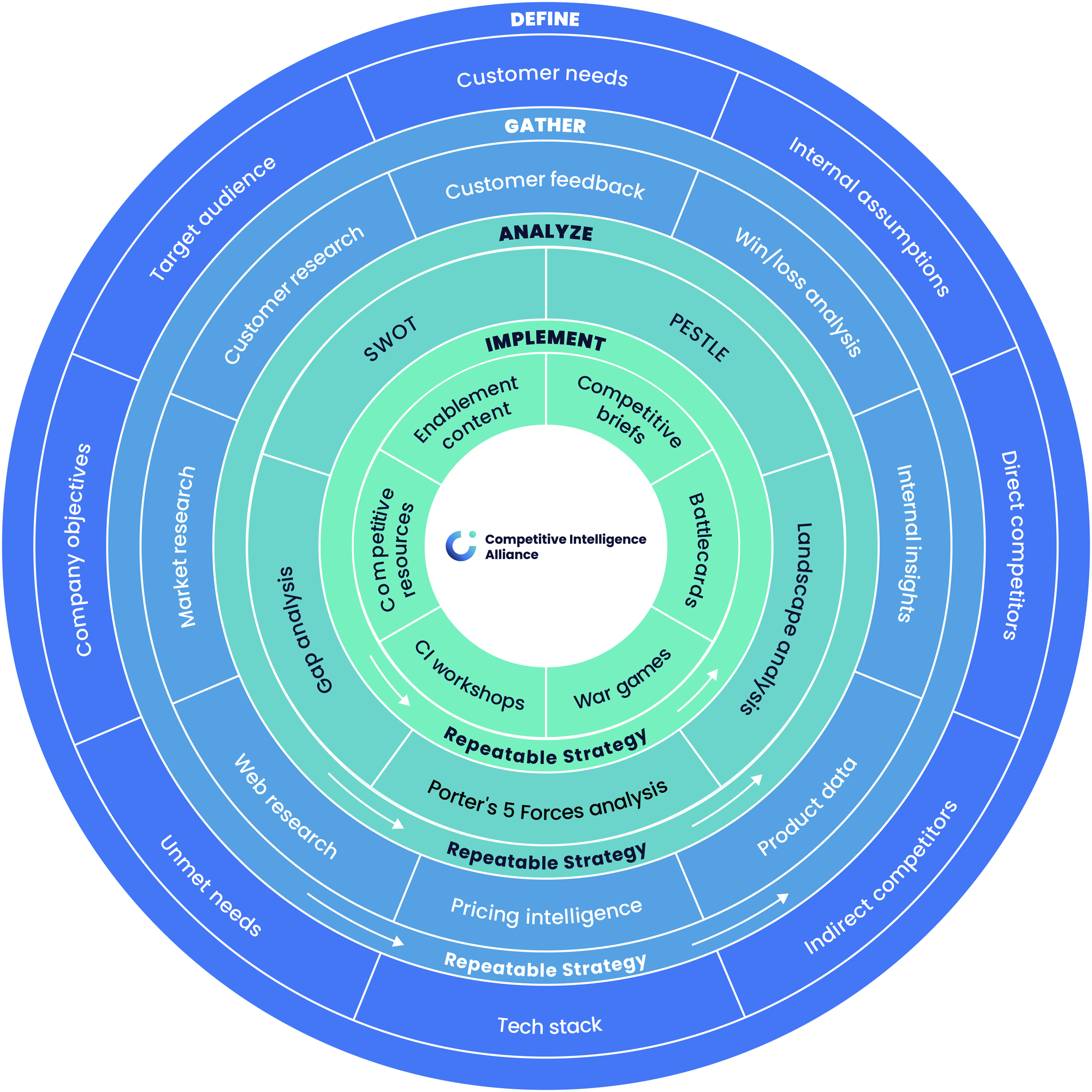
Sources of competitive intelligence: Techniques and methods
So that’s the competitive intelligence process.
But where do you actually get competitive intelligence from? What are the best competitive intelligence sources and which types of competitive intelligence should you prioritize?
Here are our top five competitive intelligence techniques:
- Win/loss analysis
- Customer research and interviews
- Competitor research
- Passive monitoring and tools
- SWOT analysis
• Win/loss analysis
Win/loss analysis is powerful.
By speaking directly to newly won and lost prospects, you get an unbiased understanding of what’s driving their decision-making. Do it right, and you’ll know exactly how to sway new leads in your favor.
And if that’s not a superpower, what is? 🦸♀️
CRM data is not enough. Real win/loss analysis involves actually interviewing customers who have recently evaluated you versus a competitor.
- Alex McDonnell, market & competitive intelligence at Airtable
• Customer research and interviews
More broadly than win/loss interviews, getting up to snuff with the opinions of your target audience makes it obvious what you’re doing well and where you can improve.
How does this tie back to your competitors? Positioning.
Over time, your product, your brand, and your business will grow and change. That’s a good thing, but it also means the sands are always shifting. You need to keep a vigilant eye on how your customers perceive you and where you’re truly winning with them.
Combine that with your research on the wider competitive landscape, and you’ll nail your place in the competitive landscape and know which battles you can win.

• Competitor research
Manually monitoring your competitors, even through a browser and a tab for each website, gives you the lowdown on their latest developments.
Most business websites publish news articles and blogs full of information about their products, business updates, even customer case studies.
Having a nosey around’ll give you a sense of their content strategy. They’ll be trying to win high-value keywords with their content, but behind this SEO strategy, they’re trying to solve customer problems. Just scanning article titles can show you the ones they think are most important, but an in-depth competitive SEO analysis is even better.
By tying these findings back to your own strategies, you can determine whether your competitors are way off the mark, or are matching you step for step.
• Passive monitoring and tools
Even the most vigilant researchers might miss something. After all, the internet’s a big place. 🕸
Passively monitoring the web for mentions of your competitors, or associated keywords and queries, can act as both a safety net in case you miss something, and as an early indicator for competitor developments.
Whether you choose Google Alerts or dedicated competitive intelligence software to take care of this stage in the data gathering pipeline, it pays to cast a wide net.
• SWOT analysis
SWOT analysis has you take a look at your competitors’ strengths and weaknesses, and the opportunities and threats present in the marketplace. But you can apply the SWOT framework to anything.
Apply it to one competitor, all your key competitors, or to the market as a whole. Apply the framework to your own organization too.
A comprehensive SWOT analysis that covers all these angles gives you a view of the whole market, and your place within it. When it comes to identifying your competitive edge, and how it might come under threat, there’s no better framework out there.
But hold on! Make sure you do your customer research first. Incorporate it into this competitor analysis. This way, you go into the process with open eyes and an objective outlook. 👀

Uses of competitive intelligence
Why use competitive intelligence at all?
There are a number of key deliverables competitive intelligence can drive, and a number of key initiatives that those deliverables support.
Let’s focus on those initiatives:
Sales and revenue enablement
The goal of any business function is to drive revenue. Whether it’s increasing customer satisfaction scores or adding new product features, trace the line back far enough and you’ll arrive at “increased revenue” as the primary motivator.
Your sales team does battle with your competitors every day. Indirectly, with their prospects as the proxy, sure. But their ability to persuade those prospects comes down to how well positioned your product and brand are against your competitors.
Enabling your sales teams to win new deals with rock-solid messaging and objection handling is just one of CI’s uses.
The best-known deliverable here is the competitive battlecard, an on-hand, scannable flashcard primed with all the sound bytes your sales reps need to handle objections and position your product as the best one to meet the customer's need.

Product positioning and messaging
Marketing teams, too, can benefit from a strong CI program.
‘Cause CI makes it clear what you do best as a business (in the objective eyes of your customers and prospects, rather than your own) and where you fall short versus certain competitors. It lets you know where your competitive advantages lie and how to stop your cheeky rivals from imitating them. 😤
With a firm grasp of your competitive advantages, you can also choose your battles more wisely. Choose the ones you’re in the best position to win, rather than competing against alternatives that are too well established, or that the market doesn’t consider similar to you.
This also informs where you choose to stand in the competitive landscape, influencing your product positioning, your messaging and value propositions, and even your product development roadmaps.
Finally, as your CI program uncovers new competitor developments, you’re in a great position to advise when it’s time to pivot and reposition.

Content strategy
Yep, competitive intelligence can even inform your content marketing strategy.
In fact, all that keyword research your content managers do is itself a form of competitor intelligence.
How, you ask? 🤨
Because they’re trying to uncover and reverse engineer your rivals’ successes.
By tracking competitor performance across keywords, and keeping an eye on the content that’s performing best in your niche, they’re finding openings in the competitive landscape to exploit and aiding strategic business decisions.
And, for your part, the intelligence you uncover will help your content writers speak confidently about competitors. It’ll help them speak about your products in relation to theirs. This competitive intelligence technique can help identify different content types and lead magnets (like video and long form ebooks) that you might want to give a shot.
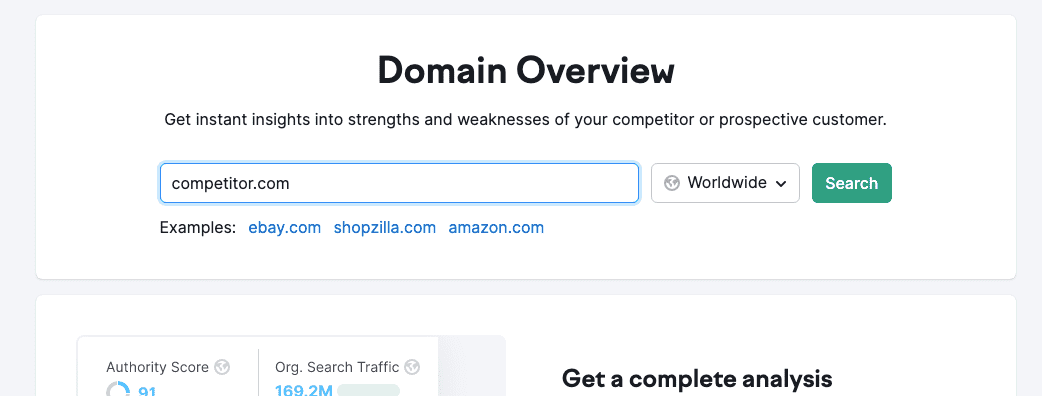
Competitive intelligence best practices
OK, so we’ve covered what competitive intelligence is. We’ve covered what sources to use, and even what to use it for.
But, in the most practical sense, how do you do it?
And, more importantly, how do you do it properly? 🤔
Here’s a shortlist of some competitive intelligence best practices we learned from industry experts in our community:
- Over-communicate
- Show your work
- Start with sales
- Before you start, orient yourself
- Prioritize, prioritize, prioritize
1) Over-communicate
Competitive intelligence is not all about data. In fact, it’s a mostly relationships-based discipline.
So, how you work and communicate with your colleagues is crucial to your success as a competitive intelligence practitioner.
This is all about building trust, so erring on the side of over-communicating is a competitive intelligence best practice. Especially at first.
That means getting your stakeholders involved early whenever you start a new project.
This helps for a few reasons:
- Gives stakeholders an opportunity to voice concerns.
- If it’s another group kicking off the project, you can be there while they’re defining the objective or research question.
- Helps to build trust and mutual respect. Both essential for a healthy ongoing working relationship.
2) Show your work
Many of CI’s outcomes aren’t so easy to measure.
So if you want career progression, you might need to work a little harder than some of your colleagues to prove your value when your next annual review rolls around.
This is especially true if yours is a business that undervalues competitive intelligence (as many businesses in Europe and APAC seem to).
So it’s a competitive intelligence best practice to dedicate a portion of your time towards evidencing the value you’ve brought to the company and the revenue you’ve been a part of generating.
Clearly track things like:
- The won deals you’ve directly contributed to.
- How many teams are asking for training and enablement sessions from you.
- The projects other people are pulling you into, and the success of those projects.
If you can supply the breadcrumb-lined path that shows how your actions have led to good outcomes, you’ll make it that much easier for your boss to agree to a pay rise.
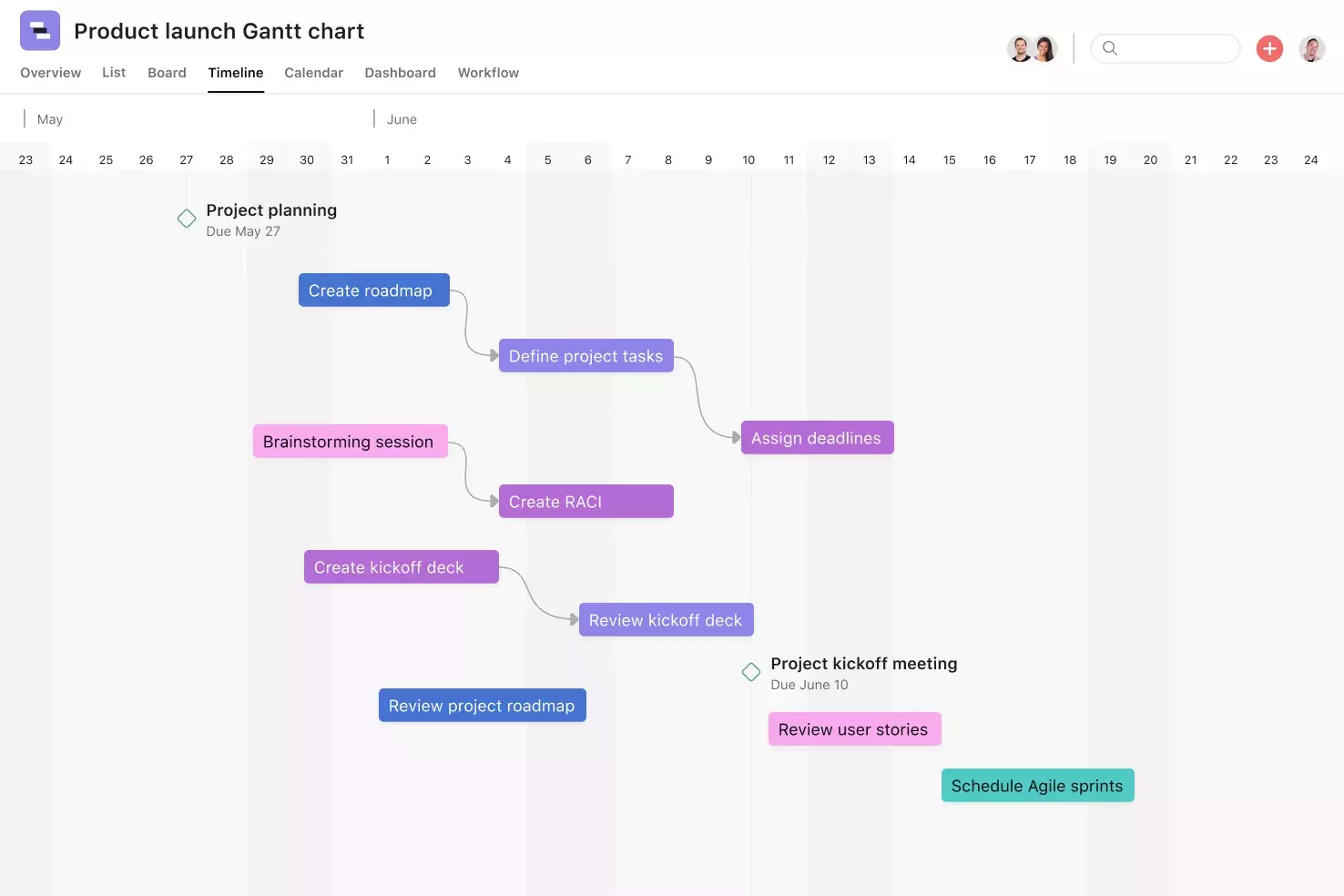
3) Start with your sales team
As we mentioned, building trust is huge. That starts with getting small wins, and building on that momentum to seize bigger wins over time.
Your sales team is a key stakeholder both early on and even after your CI program matures.
When you enable the sales team, and help them generate success, you’ll also build trust in your own abilities and in your CI program’s ability to drive positive change for the business.
Soon, other teams will come on board, and you’ll have earned your seat at the table with leadership, marketing, and product teams.
4) Orient yourself first
Sure, start with sales when you’re ready to launch your CI program in earnest.
But the very first thing to do when you land in a new competitive intelligence role is to orient yourself.
If your predecessor left behind a competitive intelligence program, best practice says to start by assessing the damage. What do you have in place that’s working? What isn’t working?
And, if there’s nothing in place at all, you have the benefit of starting with a clean slate. But if it’s your first time, blank slates can feel a bit… daunting.
For that reason, whichever scenario you find yourself in at first, it pays to orient yourself right away.
That means:
- Learning the business’ goals, and the aspirations of your leaders.
- Figuring out what competitive intelligence exists already. In the heads of your peers, in your CRM, or even scribbled in notebooks in the drawers of your salespeople.
- Learning what competitive content people like, and what they’re using most right now.
Take the lay of the land. Figure out where you are. That’s point A.
At the same time, tease out what direction your leaders want the business to head in. That’s point B.
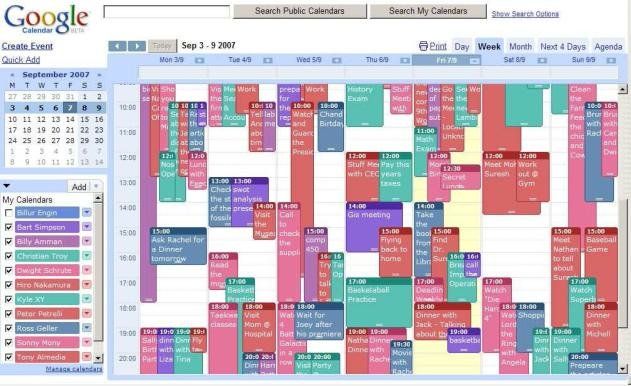
5) Prioritize, prioritize, prioritize
It’s just a fact. It’s impossible to succeed in competitive intelligence without learning to prioritize.
Competitive intelligence teams are often small. Resources are often limited. And budgets are often tight.
Yet, with so many possible stakeholders (every department in the business can benefit from competitive intelligence in some way), you’re bound to get too many requests to deal with.
Since there aren’t enough hours in the day for you (or your small team) to do everything, you have to pick your battles.
That means prioritizing on everything, including:
- Which competitors you’ll dedicate resources to monitoring, reporting on, and trying to beat.
- Which departments you’ll dedicate resources towards enabling, informing, and helping.
- Which projects you’ll spend time contributing to.
- Which types of content you’ll spend time producing.
Knowing what to prioritize and what to bump into the “later” pile comes down to being aligned with the goals of the business. See the section on ‘orienting yourself’ above.
Competitive intelligence tools
We’ve said it before, but the internet’s a big place.
Competitive intelligence software and tools can mean the difference between missing key developments and staying one step ahead.
And it doesn’t have to cost the world either. Free tools like Google Alerts can save the day when you’re out of budget. But for those with the dollars to spare, investing in the following types of tools empowers you to rapidly scale your CI program and squeeze out every last drop of its value.
- Competitive intelligence software
- Social listening tools
- Market intelligence tools
- CRMs
- Sales enablement platforms
- Conversational intelligence platforms
- Win/loss platforms
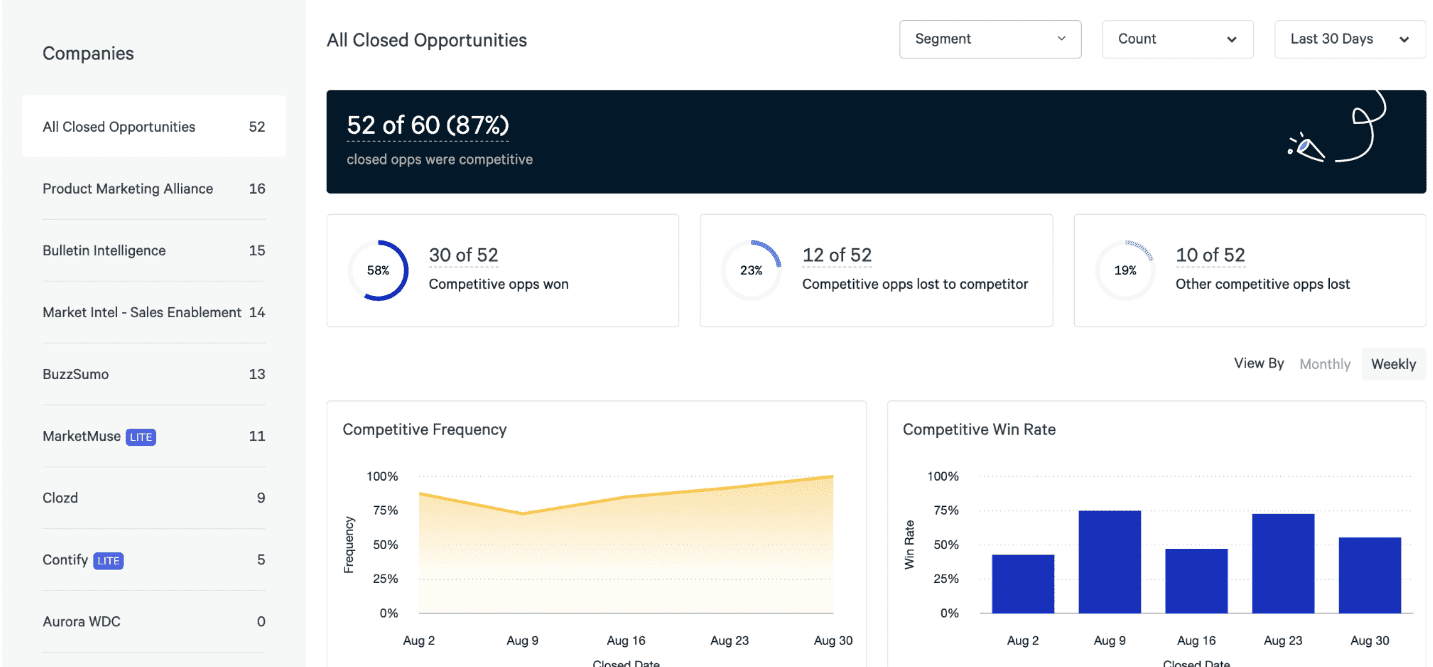
• Competitive intelligence software
Competitive intelligence software exists to make your life easier.
These tools accept a list of competitors, and they’ll monitor the web in real-time for mentions of them. That means minimal delay between a competitor’s product launch or announcement and you knowing about it.
• Social listening tools
In the other direction, you can get narrower by using a social listening tool. 👂
Rather than scanning the entire web for mentions of a competitor, these tools will scan social media platforms. These are life-changing for organizations relying on influencer marketing and social media marketing strategies.
• Market intelligence tools
Like competitive intelligence software, but for the wider marketplace.
The easiest way to understand the difference is to think of industries with only a few very strong competitors, but where both emerging and legacy players still hold a large portion of the market share.
Netflix, for example, competes closely with Amazon Prime Video and a number of other streaming service providers. But they also compete indirectly with the cable TV providers, movie theaters, and even with YouTube for people’s viewing attention.
If your organization wants intel on the wider market and its indirect competitors, they’ll benefit from a market intelligence platform.
• CRMs
Chances are your organization already uses a CRM.
Customer relationship management systems like these are the cornerstone of many a sales program, and for good reason.
A central store for everything customer- and sales lead-related, your CRM is a fab resource for gathering competitive intelligence from your sales reps. But it’s also a good place to keep your enablement assets.
Hey, your sales reps spend all day in there anyway. It’s like leaving a bowl of steaming spag’ bol’ outside your teenager’s bedroom door. You know they appreciate it, even if they don’t say so. 🍝
• Sales enablement platforms
Sales enablement platforms take the enablement function of a CRM and offer a dedicated solution for it.
Once you’ve created a framework for your sales reps that works, you can deliver it to them, track its success, and see key metrics for what’s working and what’s not.
Not enough for ya? Sales enablement tools also identify new opportunities and prospects, giving you ways to engage with them meaningfully while providing plenty of juicy data. 🍋
• Conversational intelligence software
Conversational intelligence software uses AI to analyze calls, emails, and text chat messages between sales reps and prospects.
For organizations with humongous call volumes, this makes deriving insights from conversation data scalable. And it helps you improve your buyer experience and boost conversions. 🤩
To give your data context and make next steps easier, your conversation intelligence software integrates with the other tools in your stack, including your CRM. How helpful!
• Win/loss platforms
Win/loss platforms offer supporting solutions for your win/loss research. They’ll automate this crucial part of the data gathering process for you so you can set and forget it. Nice and easy. 🙌
Since it’s always on, you’ll never miss an opportunity to gather actionable insights from newly won or lost prospects either. And the platform will give you the data you need to tweak and hone your surveys for best results.
Basically, win/loss platforms let you be lazy with a very important part of your CI process. If you’re up to your eyeballs, or if you just like to automate tasks like this, grab ya’self a subscription to some win/loss software. You won’t regret it.
A directory of tried and tested tools. 🪛
You’re drowning in work.
And that’s before you even get to your CI responsibilities. 😞
If only there was a way to automate the time-consuming tasks. To grease the wheels of key processes. To eliminate all the unnecessary drag and friction, so it takes minutes, not days, to get you up to speed.
Hold up! CI tools already do this! 🦸
Wondering which to use? We’ve got the answers.
The Competitive Intelligence Tools of Choice report has landed, with stats on the stacks the pros (that’s you! 🫵) use to get the job done.
Grab your copy. 👇
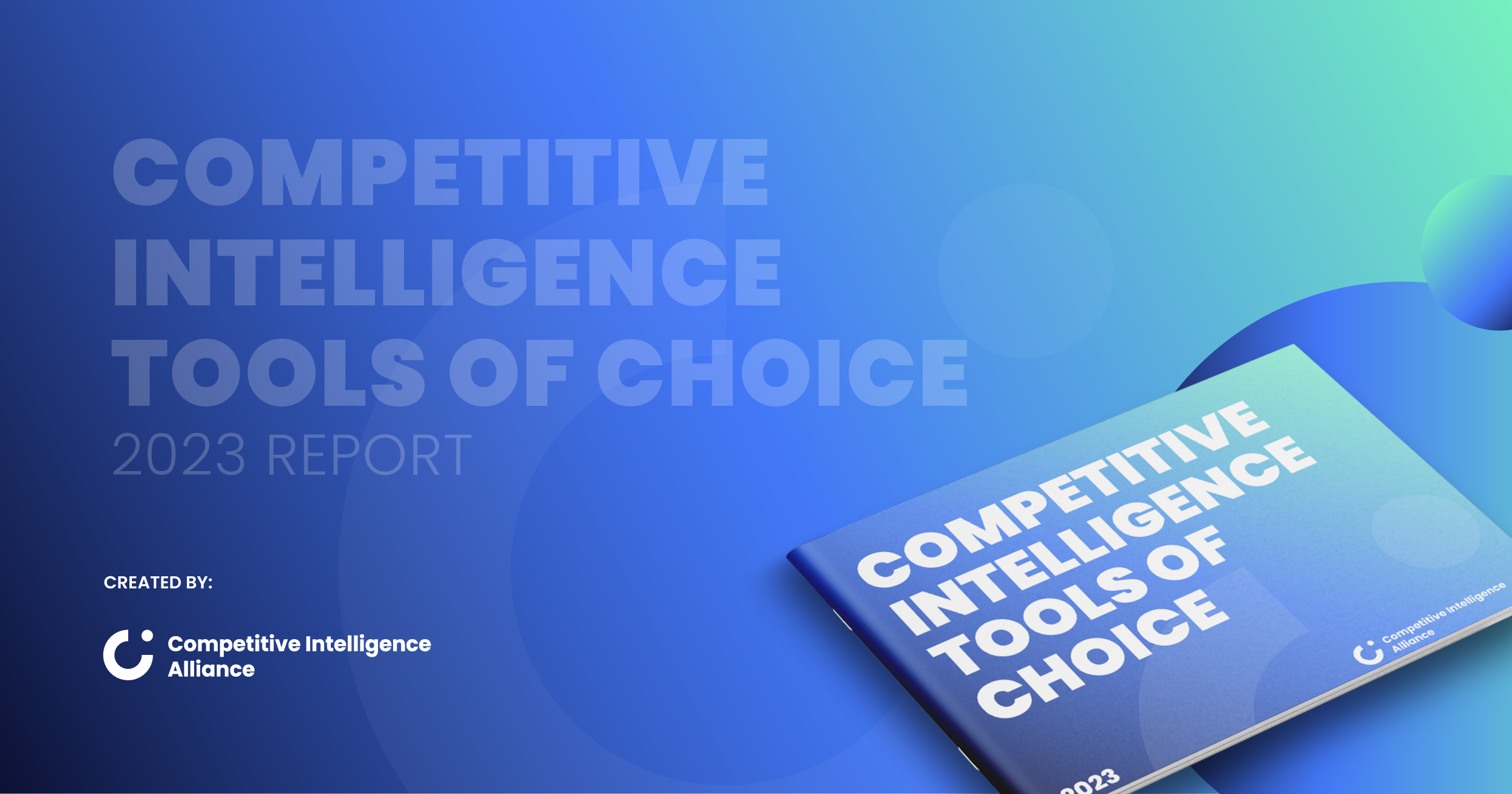
Competitive intelligence ethics
The ethics of competitive intelligence isn’t a shadowy subject hounded by shades of gray.
So long as you don’t enter the realms of corporate espionage or illegal activity (like wiretapping your rival’s phone lines or cracking their customer database), you’ll be on the right side of the ethical divide.
Information from publicly available sources is all you need to succeed. Customer reviews, competitor press releases, announcements, social media posts, and even published financial statements.
All of these are legal and ethical sources of intel on your competitors. In fact, you’ll probably struggle to keep up with all of it, which is why automation via competitive intelligence tools can be so powerful.
But developments can be subtle, and the signs often lie in small departures from baseline behavior. That’s why it’s so important to ID that baseline and become intimately familiar with your core competitors. The ones that represent your greatest opportunities.
More competitive intelligence resources
- Competitive intelligence Slack community
- Competitive intelligence articles
- Competitive intelligence newsletter: CIA Signal
Give yourself an unfair advantage
Our newest competitive intelligence course lifts the lid on the frameworks and processes experts use to deliver impactful intel with confidence.
You can expect:
- A 100% self-paced and online course packed with competitive wisdom so you can stop worrying and start winning.
- Bonus features from established competitive professionals to give you an unfair advantage.
- 6 downloadable, customizable templates and frameworks that make analysis a cinch.
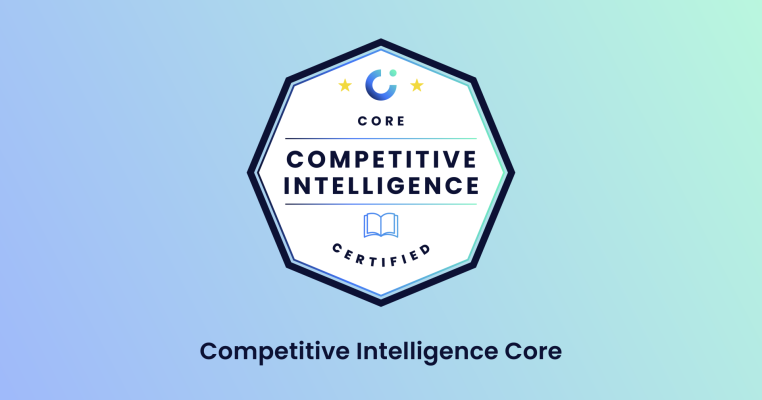
Competitive Intelligence: Core
We'll show you how to:
- 👑 Lead development of your org’s all-important competitive positioning.
- 🦾 Master CI’s essentials, including its most powerful research techniques.
- 🚀 Arm sales and customer success with intel to skyrocket win rates and turn down churn.
- 🧠 Offer leaders critical intel that informs their decision-making and strategy.
- 📈 Elevate CI’s role within your org to ensure career progression.






.png?v=09cf73b4b5)